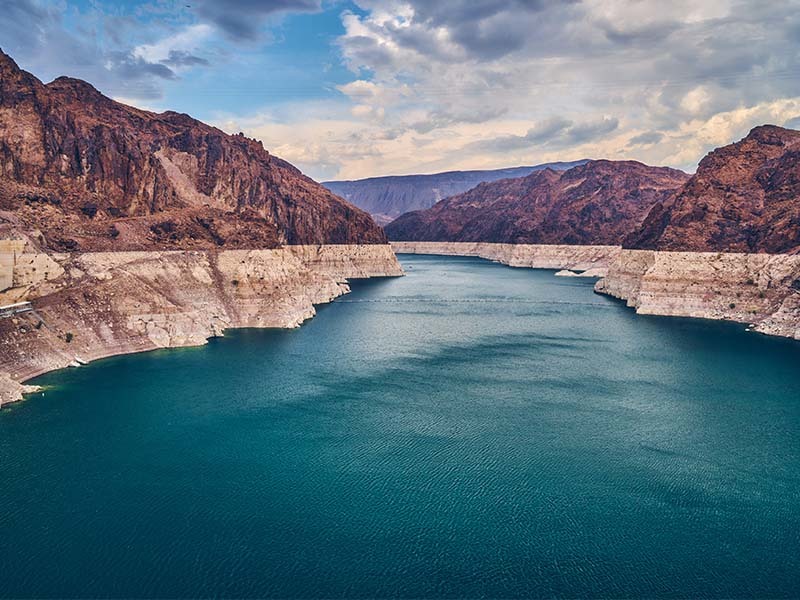Water scarcity was prominent among 2021 headlines, which peaked in August when federal officials declared a first-ever water shortage in the Colorado River Basin after Lake Mead reached record-low levels. Terms such as water scarcity, drought, water stress, and water risk all communicate the societal impacts of water’s limited availability. However, they are often used interchangeably and can take on different meanings depending on context. Using the Colorado River Basin as a framework for discussion, this article will differentiate these concepts to better understand how they are connected. We have a role to play as water users, and our actions impact the severity of these situations for ourselves and others.
The Colorado River Basin supplies water to seven U.S. states and parts of Mexico. Lake Mead is the largest reservoir in the United States, located in the Lower Basin and formed by the Hoover Dam. After prolonged drought in the region, a contingency plan was enacted in 2019 and established 1,075 feet as a critical level for Lake Mead. The Bureau of Reclamation issued a Tier 1 water shortage for Lake Mead because water had fallen below that level and projections showed no indication of recovery by January 2022. Consequently, mandatory supply cuts went into effect beginning in 2022 for Arizona, Nevada, and Mexico. Lake Powell, located in the Upper Basin and the nation’s second largest reservoir, is also at a historically low level but still above its Tier 1 water shortage threshold.
In general, water scarcity refers to a physical and quantifiable amount of freshwater resources relative to the amount of human consumption. A water scarce region implies that the human demand and consumption outweighs the availability of freshwater, causing an unsustainable imbalance leading to declining water resources over time. A dry area alone would not be considered water scarce unless there were also a human presence or demand for whatever water is available. Human actions drive water scarcity but can also prevent it through management practices. The situation at Lake Mead is a good example of water scarcity because human water use is exceeding the natural availability and drawing down reserves. The Tier 1 mandatory cuts are part of management measures to address the imbalance.
Drought is a natural condition and a temporary situation of water resources being below average for a specific region. Humans cannot stop drought from occurring, but we can account for it in a water management plan, such as assigning allocation limits to help prevent water scarcity. Although prolonged drought has certainly played a role in the levels of Lake Mead, it is the human consumption beyond the natural availability that is driving the water scarcity condition. While reservoirs are meant to mitigate risks associated with drought, the amassed water may also enable overconsumption by delaying the effects of a long-term imbalance.
Water stress can account for several factors, including water scarcity and often water quality, treatability, and accessibility. A region’s available infrastructure and socioeconomic conditions play a role as do societal expectations and relative standards of living, which makes water stress a subjective term that is difficult to quantify across diverse regions. Therefore, context is important to define an otherwise ambiguous term that could imply many different things.
Water risk impacts us all. However, it is of particular concern for Kurita America’s clients and other businesses who rely on freshwater resources for their products, processes, and utilities. Water risk is the possible impact on an entity through a water-related challenge, which could include water scarcity, drought, water stress, or even natural disasters, like flooding. Many companies are investing in sustainability initiatives to mitigate water risk and ensure continued operation and profitability through the unpredictable effects of water scarcity. When factoring water risk considerations, Barclays Investment Bank estimated the true cost of water at three (3) to five (5) times higher than what companies are currently paying. On average, global municipal water prices have doubled over the past decade, and the value gap suggests a continued upward trend.
The Tier 1 water restrictions only affect Lower Basin users of Lake Mead, although the entire Colorado River Basin and those who rely on it have been impacted by efforts to maintain the level of Lake Mead through over two decades of sustained drought. The Lower Basin and Lake Mead are supplied by Lake Powell in the Upper Basin with flow controlled through the Glen Canyon Dam. The 2019 drought contingency plan included the release of additional water from Lake Powell as well as conservation efforts from the Lower Basin to reduce use and diversify water sources. There are some who advocate drawing down Lake Powell and closing the Glen Canyon Dam for the benefit of Lake Mead and the Hoover Dam. Lower water levels have already affected power generation at both dams, and such a decision may be inevitable if levels decline further.
Kurita America is dedicated to helping society and the natural environment coexist in harmony through water. Kurita is a leading member the Water Resilience Coalition (WRC), which is an industry-driven, CEO-led initiative to preserve the world’s freshwater resources. The WRC is working to build the resilience of water-stressed basins around the world, prioritizing those that pose the greatest risk to local communities and economies, industry, and long-term economic prosperity. In the United States, these include the Colorado and Mississippi River Basins. WRC member companies pledge to accomplish three overarching commitments by 2050: (1) deliver a measurable net positive impact in water-stressed basins, (2) develop a water resilient value chain, and (3) demonstrate global leadership to elevate the importance of water resilience and inspire other industry leaders to join the Coalition.
At our core, Kurita America helps clients develop and implement their water management operations by providing effective water treatment programs and informed design. Our solutions ensure that you get the most out of your water, which minimizes your water risk while combatting water scarcity and alleviating water stress. Water reuse is an important concept in this regard, and the ability to repurpose process water that would otherwise be sent to waste may offer the most resilience when facing water risk.
Contact your Kurita America representative to find out how we can help you achieve your water sustainability goals.
 About the Author: T.J. Stroebl is a technical marketing leader at Kurita America, specializing in equipment systems. After earning a chemical engineering degree from the University of Minnesota, he has spent his career with Kurita America focusing on process and equipment design, troubleshooting, and development relevant to water treatment systems. T.J. is an active member of the American Water Works Association (AWWA), currently serving as vice chair on the Manufacturers/Associates Council (MAC).
About the Author: T.J. Stroebl is a technical marketing leader at Kurita America, specializing in equipment systems. After earning a chemical engineering degree from the University of Minnesota, he has spent his career with Kurita America focusing on process and equipment design, troubleshooting, and development relevant to water treatment systems. T.J. is an active member of the American Water Works Association (AWWA), currently serving as vice chair on the Manufacturers/Associates Council (MAC).

